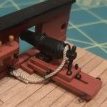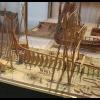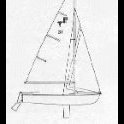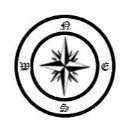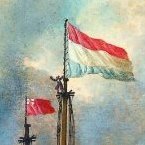MORE HANDBOOKS ARE ON THEIR WAY! We will let you know when they get here.
×
-
Posts
10,214 -
Joined
-
Last visited
Reputation Activity
-
 ccoyle got a reaction from EricWilliamMarshall in Part VI: Building V108 - The Superstructure
ccoyle got a reaction from EricWilliamMarshall in Part VI: Building V108 - The Superstructure
Next up is the conning tower. The first thing to take note of is the parts are misnumbered. This is not an uncommon error in card models, where the model, the diagrams, the parts sheets, and the instructions are often all produced by one person -- without the benefit of a proofreader and perhaps also without the hindsight of a beta build. So, no big deal. The misnumbered part is 27d, which should be 24a. You'll also need 24b. 24c are the bridge wing support girders, which we won't need right away.
Normally, I would tell you to cut out 24b after scoring the fold lines and form it, but here's where you get the benefit of my building the model first. There's a big error with part 24b -- once it is cut and folded properly, it doesn't fit!
So here's how I fixed the problem. Cut part 24b apart along one of the rear fold lines. Measure and remove the excess part of the rear panel. We're going to put this excess colored panel to work. Notice that at the back of the conning tower portion of the parts 23 sub-assembly, there are two glue tabs; those should actually be part of the conning tower wall. Use the scrap piece from part 24b to make two rectangular panels to cover those glue tabs. The finished task will look like this:
Part 24b is now in two pieces. Glue the part with the rear wall to part 24a (the misnumbered '27d'). Now, use some scrap card to create a joiner tab for the two parts of 24b. Attach it thus:
Add the rest of 24b (don't forget to color edges as you work!).
So -- problem fixed. Next, add some joiner strips to the outline on top of the superstructure.
Glue the conning tower down with some white glue.
This assembly is a good example of the relative ease with which fit problems like this can fixed in the card medium. I don't think plastic or resin would have been as easy!
One other thing to take note of in this section is what happens when you create a 90 degree fold in card:
The ink layer is only on the very surface of the paper; very sharp bends will tend to crack this layer. Make sure to color the resulting exposed card fibers, either by painting or running a marker along the fold.
-
 ccoyle reacted to gjdale in Pt. V: Building V108 - The Hull
ccoyle reacted to gjdale in Pt. V: Building V108 - The Hull
This really is a great tutorial Chris. The "warts and all" approach makes it seem that much more accessible to first timers.
-
 ccoyle got a reaction from BenD in Pt. V: Building V108 - The Hull
ccoyle got a reaction from BenD in Pt. V: Building V108 - The Hull
Ack! Almost forgot a few hull details.
Parts 21 are the propeller guards. Small parts like these that have substantial cut-out areas are flimsy once removed from the sheet, so it helps to do some of the prep work while they're still on the sheet. Start by coloring the reverse sides of the parts. Then, cut out the inside white areas, but leave the outer edge attached. You can then edge-color the interiors of the parts. When the interiors are done, remove the parts from the sheet and color the outer edge. Glue the guards to the hull with small amounts of PVA. Note that the guards follow the curvature of the stern, so the left and right guards are not interchangeable.
The rudder (part 22) introduces a new kit feature, the two-sided part.
Score the fold line, then cut out the entire rectangle containing the part. Apply glue to one-half of the back side of the part, then fold the rectangle in half. You now have a rudder colored on both sides! Remember, though, we're only using the part above the waterline, so go ahead and remove the red portion. Color the trailing edge and then glue the rudder to the stern; there's a locator mark there to help you. The rudder post will stick up above the deck just a little.
Here's the guards and rudder installed:
Okay, now we can move on to deck structures!
On to Part VI: Building V108 - The Superstructure
-
 ccoyle reacted to Pete38 in Pt. V: Building V108 - The Hull
ccoyle reacted to Pete38 in Pt. V: Building V108 - The Hull
Very interesting.....Going to have to get my printer up and going so I can get in on this...
will be downloading the post and saving them on my computer...
Thanks very much....very nice and detailed tutorial
-
 ccoyle got a reaction from Canute in Pt. V: Building V108 - The Hull
ccoyle got a reaction from Canute in Pt. V: Building V108 - The Hull
Once the laminated parts have dried, it is time to start cutting. Here's the complete set of hull framing parts cut from their sheets.
Right away you might wonder, do I cut on the line, outside the line, or inside the line? This might seem like a silly question considering that this kit has very fine borders. But not all kits have such fine artwork. Worse perhaps is that there is no consensus among designers about whether the line is part of a part or not. And if you use headband magnifiers while cutting, which I do because of my bad eyesight, you'll discover that even with very fine lines it is possible to cut on, outside, or inside lines. So, how should we treat this kit? Answer: I tend to cut along the inside edge of the line. Be advised that if you use chipboard, it is like rock compared to ordinary card. My #11 blade tip broke on only the second part. But have no fear - the remainder of the blade actually cuts chipboard better without the missing tip (the tip is essential for controlled cutting on plain card, though). In fact, I only needed one blade to cut out all the 1 mm parts.
And now we can start gluing! The first step is to glue the two halves of the hull base plate together. I'm using Elmer's yellow wood glue -- it grabs pretty fast. Glue the butt joint first, then use two pieces of scrap chipboard to reinforce the joint.
Once this is done, it's time to fix the hull bottom to a temporary working base -- something rigid that will keep the hull from warping during construction. I use a small piece of plate glass. I apply a spot of rubber cement at the bow, midships, and stern. The rubber cement will allow the hull to be easily removed later.
Next, start dry fitting the hull frames. Remember -- fit twice, glue once! It is important that the bulkheads sit flush with the longitudinal frame. Trim where necessary.
Some of the frames will need to be beveled where they meet curved portions of the hull. The bow end of the longitudinal frame also needs beveling.
Once all the frames are correctly trimmed, they can be glued to the hull base plate, starting with the longitudinal frames (two parts), then adding the eight bulkheads. It is more important that the bulkheads are flush with the edges of the base plate than perfectly sitting on their locator lines, but they should be close. Once all the frames are glued in, add some extra weight to the hull so the finished model will have some 'heft'. Here you can see where I've glued in some lead fishing weights.
Next comes the main deck. Note that there are some red portions on these pieces. The red areas need to be cut or drilled out before assembly. Don't worry too much about the drilling, because it can be done on the assembled hull. But the cut-out portions definitely should be removed in advance.
Now's the time to discuss edge coloring. As you can see, the cut-out parts have white edges. There are three schools of thought on how to treat these. Some modelers don't color edges; they think of the visible edges as a badge of card modeling honor. Personally, I am mortified by untreated edges. The second school consists of those who go to great lengths to find or mix watercolors, acrylics, or gouache to match the printed colors exactly. These modelers may also fill and sand any gaps in the seams. The Poles are masters at this technique, but it is a lot of work. If that floats your boat, go for it. I subscribe to the third school: edges should be visually minimized. The idea is to make the seams and exposed edges less obvious, but not necessarily invisible. For this model, most any shade of gray felt-tip marker will suffice for edge coloring. A gray edge on a gray model is far less conspicuous than a white edge on a gray model. If you choose this option, test your markers to make sure they don't bleed too far into the paper fibers. Particularly good markers for this task are acrylic paint markers such as those used by plastic modelers.
Once the deck edges are colored, the two halves can be glued and reinforced in the same manner as the base plate.
Once that's dry, we can then glue the main deck down onto the hull frames. Apply glue to the tops of the frames and slip the deck over the two smokestack profiles. Note that the stack profiles fit through the slots we previously cut from the deck. Make sure the tops of the bulkheads are flush with the deck edges.
It helps to add some weight on top of the deck while the glue dries. A couple of small but heavy books will do.
Till next time!
-
 ccoyle got a reaction from catopower in Pt. II: Start for FREE!
ccoyle got a reaction from catopower in Pt. II: Start for FREE!
First of all, never download a model from a third party file sharing site. Always download models from the designer's own web site or a site authorized to host them. Second, never buy CD's claiming to have "hundreds of models" from auction sites like eBay -- these are inevitably scans of commercial kits. If you shop at eBay or somewhere similar on-line, make sure the seller displays a photo of the printed kit booklet; it should have an artwork cover with the publisher's name plainly visible.
-
 ccoyle got a reaction from 42rocker in Pt. II: Start for FREE!
ccoyle got a reaction from 42rocker in Pt. II: Start for FREE!
First of all, never download a model from a third party file sharing site. Always download models from the designer's own web site or a site authorized to host them. Second, never buy CD's claiming to have "hundreds of models" from auction sites like eBay -- these are inevitably scans of commercial kits. If you shop at eBay or somewhere similar on-line, make sure the seller displays a photo of the printed kit booklet; it should have an artwork cover with the publisher's name plainly visible.
-
 ccoyle got a reaction from ianmajor in Pt. II: Start for FREE!
ccoyle got a reaction from ianmajor in Pt. II: Start for FREE!
First of all, never download a model from a third party file sharing site. Always download models from the designer's own web site or a site authorized to host them. Second, never buy CD's claiming to have "hundreds of models" from auction sites like eBay -- these are inevitably scans of commercial kits. If you shop at eBay or somewhere similar on-line, make sure the seller displays a photo of the printed kit booklet; it should have an artwork cover with the publisher's name plainly visible.
-
 ccoyle got a reaction from mtaylor in Pt. II: Start for FREE!
ccoyle got a reaction from mtaylor in Pt. II: Start for FREE!
First of all, never download a model from a third party file sharing site. Always download models from the designer's own web site or a site authorized to host them. Second, never buy CD's claiming to have "hundreds of models" from auction sites like eBay -- these are inevitably scans of commercial kits. If you shop at eBay or somewhere similar on-line, make sure the seller displays a photo of the printed kit booklet; it should have an artwork cover with the publisher's name plainly visible.
-
 ccoyle got a reaction from flying_dutchman2 in Pt. IV: Tools & Other Supplies
ccoyle got a reaction from flying_dutchman2 in Pt. IV: Tools & Other Supplies
UPDATED JULY 2024
Only a few tools are needed to get started in card modeling. At the very least, you need a cutting tool and some glue. Everything else is optional.
Here are some basic tools:
You'll need a self-healing cutting mat, available from most office supply or crafts stores. Next, you need something to cut with. Most card modelers do not use scissors. A garden-variety craft knife does the job nicely and with more precision. Some card modelers use scalpels. Get a good supply of #11 blades -- card can be surprisingly hard on them. A steel rule is a must, not just for measuring, but more importantly for cutting straight lines.
Glue is, of course, essential. A variety of glues will work. Each has its own merits and drawbacks. PVA glue, either white (e.g., Elmer's) or yellow (wood glue) are good general purpose glues. Lately I have grown fond of Evergreen's Canopy Glue, which is a PVA-type glue that grabs quickly and dries fast. Bear in mind that PVA glues are water-based, and card can absorb the glue and deform. PVA is therefore not a good choice for gluing large surfaces together.
Cyanoacrylate glue, or CA ('Super Glue'), has its uses. Fast-cure CA can be wicked into card stock to stiffen it. Medium-cure CA is useful for gluing parts made of different media together, as well as for paper-to-paper bonds.
Contact cement (not to be confused with rubber cement) is a non-water-based glue and thus good for gluing large surfaces together. Contact cement sets rapidly, so repositioning of parts once they come in contact with each other is not possible.
Now, on to some optional items.
From left to right:
blackened, annealed wire - an assortment of diameters is useful for making gun barrels, railings, etc. styrene rod - card can be rolled into tubes, but styrene is often a better choice assorted paint brushes - for painting and as aids for rolling tubes tweezers paint, marking pens, or other media for coloring cut edges (more on this later) calipers - for measuring card stock thickness, especially when laminating sheets together hobby pliers (not pictured) - for cutting and forming wire (end nippers, needle nose, round nose)
Some other useful items to have are thin, flexible, clear acetate sheets (for glazing windows), matte clear spray varnish (for prepping parts sheets), and 3M spray adhesive (for laminating card and/or paper sheets together). 3M costs more than other brands, but take my advice, it's worth the money. Cheaper brands don't coat as evenly and produce clumpier spray patterns. Trust me -- I learned this the hard way.
I'll add other items if I remember them. Now, go get your supplies and let's build a model!
Back to Part III: Shopping for Card Models On to Part V: Building V108 - The Hull
-
 ccoyle got a reaction from BenD in Pt. III: Shopping for Card Models
ccoyle got a reaction from BenD in Pt. III: Shopping for Card Models
UPDATED 7/2024
This tutorial is based on a free kit. But supposing you wished to buy a paper model kit, where could you get one?
Let's start with The Big Question on everyone's mind: Who makes the 'best' kits? The first thing you must do is separate in your mind the concepts of best kit and best kit designer. They are not the same thing. Some designers publish their own models, but many don't. Their kits are printed by various publishing houses -- often more than one. This fact makes it difficult to generalize about this publisher versus that publisher. Your favorite designer might have his designs printed by multiple publishers. The lesson here is that it pays to take note of who designed a particular kit you like. Then you look for that designer's work at various publishing houses. Another thing to make note of is a kit's date of publication. CAD designing did not become commonplace until about the turn of the new century. Prior to that, kits were hand drawn. Thus, the older a kit is, the more likely it is to be hand-drawn. This doesn't mean that hand-drawn kits are necessarily bad. It just means that an older kit may not live up to the current standards detail, fit, and artwork.
With all that in mind, let's take a look at some of the major publishing firms. This is by no means an exhaustive list. It's just to give you a sample of what's available. You can follow the embedded links to each publisher's website.
WAK: This is currently my favorite Polish publisher and shop, as they have the best shipping rates to the US.
GPM: GPM are one of the largest card model publishers in Poland. They have a large selection of ship models in many scales, both in their own line and from many other publishers as well. They also have an extensive inventory of after-market accessories.
Modelik: Modelik carries only their own line of models, but as discussed previously, these are not all the work of one designer. Modelik kits are generally well-regarded in the hobby.
JSC: JSC have an extensive line of ship models. They are one of the few Polish publishers to offer a large selection of models in scales other than the usual 1/200 favored in that country. JSC kits are normally either 1/250 or 1/400. Many of JSC's kits are older, hand-drawn designs.
Kartonowy Arsenal (KA): Better known as Halinski, KA offer highly detailed models. KA kits are best suited for advanced modelers.
Orel: This Ukrainian publisher is prolific. They offer a large selection of Czarist-era warships, sailing vessels, and Civil War ironclads, mostly in 1/200 scale.
HMV: The Hamburger Modellbaubogen Verlag is probably the premier German ship model source. Their kits are published in 1/250 scale, the scale preferred in Germany. They have a wide selection of warships, passenger ships, and merchantmen. They also offer an extensive line of after-market detail sets.
Moewe Verlag: Also known as Wilhelmshavener, this publisher has an extensive line of warships, passenger ships, and merchantmen in 1/250. Ordering from them can be kind of tricky, since many of their kits are older hand-drawn models, and this isn’t indicated in the product description. MV kits tend to be less detailed than HMV kits, but they have a broader selection and somewhat lower prices. They don’t offer after-market detail sets.
J F Schreiber: Schreiber are the third major German publisher. Their kits are, as a rule, less detailed than either HMV or Moewe, but they offer more kits of simpler subjects suited to beginning modelers. They also offer more kits in 1/100 scale than other publishers. Schreiber operates an on-line store.
Paper Shipwright: Designer David Hathaway’s line of kits is unique in its extensive offering of monitors. David also designs small passenger craft and working vessels. These are generally very good kits and also reasonably priced, with a fair but not overwhelming amount of detail. Paper Shipwright kits can be ordered directly from their website.
Shipyard: A publisher of sailing subjects in 1/72 and 1/96 scales. Shipyard kits are available in the US from Ages of Sail.
Seahorse: Sailing subjects in a variety of scales.
In addition to the publishers just listed, there are some e-commerce sites that sell card models in general. I'll list a few of them here.
Karton Modell Shop (Germany)
Marcle Models (UK)
E-Cardmodels (digital downloads only)
Have fun browsing!
Back to Part II: Start for FREE! On to Pt. IV: Tools & Other Supplies
-
 ccoyle got a reaction from Stevinne in Pt. III: Shopping for Card Models
ccoyle got a reaction from Stevinne in Pt. III: Shopping for Card Models
UPDATED 7/2024
This tutorial is based on a free kit. But supposing you wished to buy a paper model kit, where could you get one?
Let's start with The Big Question on everyone's mind: Who makes the 'best' kits? The first thing you must do is separate in your mind the concepts of best kit and best kit designer. They are not the same thing. Some designers publish their own models, but many don't. Their kits are printed by various publishing houses -- often more than one. This fact makes it difficult to generalize about this publisher versus that publisher. Your favorite designer might have his designs printed by multiple publishers. The lesson here is that it pays to take note of who designed a particular kit you like. Then you look for that designer's work at various publishing houses. Another thing to make note of is a kit's date of publication. CAD designing did not become commonplace until about the turn of the new century. Prior to that, kits were hand drawn. Thus, the older a kit is, the more likely it is to be hand-drawn. This doesn't mean that hand-drawn kits are necessarily bad. It just means that an older kit may not live up to the current standards detail, fit, and artwork.
With all that in mind, let's take a look at some of the major publishing firms. This is by no means an exhaustive list. It's just to give you a sample of what's available. You can follow the embedded links to each publisher's website.
WAK: This is currently my favorite Polish publisher and shop, as they have the best shipping rates to the US.
GPM: GPM are one of the largest card model publishers in Poland. They have a large selection of ship models in many scales, both in their own line and from many other publishers as well. They also have an extensive inventory of after-market accessories.
Modelik: Modelik carries only their own line of models, but as discussed previously, these are not all the work of one designer. Modelik kits are generally well-regarded in the hobby.
JSC: JSC have an extensive line of ship models. They are one of the few Polish publishers to offer a large selection of models in scales other than the usual 1/200 favored in that country. JSC kits are normally either 1/250 or 1/400. Many of JSC's kits are older, hand-drawn designs.
Kartonowy Arsenal (KA): Better known as Halinski, KA offer highly detailed models. KA kits are best suited for advanced modelers.
Orel: This Ukrainian publisher is prolific. They offer a large selection of Czarist-era warships, sailing vessels, and Civil War ironclads, mostly in 1/200 scale.
HMV: The Hamburger Modellbaubogen Verlag is probably the premier German ship model source. Their kits are published in 1/250 scale, the scale preferred in Germany. They have a wide selection of warships, passenger ships, and merchantmen. They also offer an extensive line of after-market detail sets.
Moewe Verlag: Also known as Wilhelmshavener, this publisher has an extensive line of warships, passenger ships, and merchantmen in 1/250. Ordering from them can be kind of tricky, since many of their kits are older hand-drawn models, and this isn’t indicated in the product description. MV kits tend to be less detailed than HMV kits, but they have a broader selection and somewhat lower prices. They don’t offer after-market detail sets.
J F Schreiber: Schreiber are the third major German publisher. Their kits are, as a rule, less detailed than either HMV or Moewe, but they offer more kits of simpler subjects suited to beginning modelers. They also offer more kits in 1/100 scale than other publishers. Schreiber operates an on-line store.
Paper Shipwright: Designer David Hathaway’s line of kits is unique in its extensive offering of monitors. David also designs small passenger craft and working vessels. These are generally very good kits and also reasonably priced, with a fair but not overwhelming amount of detail. Paper Shipwright kits can be ordered directly from their website.
Shipyard: A publisher of sailing subjects in 1/72 and 1/96 scales. Shipyard kits are available in the US from Ages of Sail.
Seahorse: Sailing subjects in a variety of scales.
In addition to the publishers just listed, there are some e-commerce sites that sell card models in general. I'll list a few of them here.
Karton Modell Shop (Germany)
Marcle Models (UK)
E-Cardmodels (digital downloads only)
Have fun browsing!
Back to Part II: Start for FREE! On to Pt. IV: Tools & Other Supplies
-
 ccoyle got a reaction from EricWilliamMarshall in Pt. III: Shopping for Card Models
ccoyle got a reaction from EricWilliamMarshall in Pt. III: Shopping for Card Models
UPDATED 7/2024
This tutorial is based on a free kit. But supposing you wished to buy a paper model kit, where could you get one?
Let's start with The Big Question on everyone's mind: Who makes the 'best' kits? The first thing you must do is separate in your mind the concepts of best kit and best kit designer. They are not the same thing. Some designers publish their own models, but many don't. Their kits are printed by various publishing houses -- often more than one. This fact makes it difficult to generalize about this publisher versus that publisher. Your favorite designer might have his designs printed by multiple publishers. The lesson here is that it pays to take note of who designed a particular kit you like. Then you look for that designer's work at various publishing houses. Another thing to make note of is a kit's date of publication. CAD designing did not become commonplace until about the turn of the new century. Prior to that, kits were hand drawn. Thus, the older a kit is, the more likely it is to be hand-drawn. This doesn't mean that hand-drawn kits are necessarily bad. It just means that an older kit may not live up to the current standards detail, fit, and artwork.
With all that in mind, let's take a look at some of the major publishing firms. This is by no means an exhaustive list. It's just to give you a sample of what's available. You can follow the embedded links to each publisher's website.
WAK: This is currently my favorite Polish publisher and shop, as they have the best shipping rates to the US.
GPM: GPM are one of the largest card model publishers in Poland. They have a large selection of ship models in many scales, both in their own line and from many other publishers as well. They also have an extensive inventory of after-market accessories.
Modelik: Modelik carries only their own line of models, but as discussed previously, these are not all the work of one designer. Modelik kits are generally well-regarded in the hobby.
JSC: JSC have an extensive line of ship models. They are one of the few Polish publishers to offer a large selection of models in scales other than the usual 1/200 favored in that country. JSC kits are normally either 1/250 or 1/400. Many of JSC's kits are older, hand-drawn designs.
Kartonowy Arsenal (KA): Better known as Halinski, KA offer highly detailed models. KA kits are best suited for advanced modelers.
Orel: This Ukrainian publisher is prolific. They offer a large selection of Czarist-era warships, sailing vessels, and Civil War ironclads, mostly in 1/200 scale.
HMV: The Hamburger Modellbaubogen Verlag is probably the premier German ship model source. Their kits are published in 1/250 scale, the scale preferred in Germany. They have a wide selection of warships, passenger ships, and merchantmen. They also offer an extensive line of after-market detail sets.
Moewe Verlag: Also known as Wilhelmshavener, this publisher has an extensive line of warships, passenger ships, and merchantmen in 1/250. Ordering from them can be kind of tricky, since many of their kits are older hand-drawn models, and this isn’t indicated in the product description. MV kits tend to be less detailed than HMV kits, but they have a broader selection and somewhat lower prices. They don’t offer after-market detail sets.
J F Schreiber: Schreiber are the third major German publisher. Their kits are, as a rule, less detailed than either HMV or Moewe, but they offer more kits of simpler subjects suited to beginning modelers. They also offer more kits in 1/100 scale than other publishers. Schreiber operates an on-line store.
Paper Shipwright: Designer David Hathaway’s line of kits is unique in its extensive offering of monitors. David also designs small passenger craft and working vessels. These are generally very good kits and also reasonably priced, with a fair but not overwhelming amount of detail. Paper Shipwright kits can be ordered directly from their website.
Shipyard: A publisher of sailing subjects in 1/72 and 1/96 scales. Shipyard kits are available in the US from Ages of Sail.
Seahorse: Sailing subjects in a variety of scales.
In addition to the publishers just listed, there are some e-commerce sites that sell card models in general. I'll list a few of them here.
Karton Modell Shop (Germany)
Marcle Models (UK)
E-Cardmodels (digital downloads only)
Have fun browsing!
Back to Part II: Start for FREE! On to Pt. IV: Tools & Other Supplies
-
 ccoyle got a reaction from Nearshore in Pt. II: Start for FREE!
ccoyle got a reaction from Nearshore in Pt. II: Start for FREE!
UPDATED JULY 2024
How would you like try building a model for free? Not only that, but how would you like to have as many attempts at completing it as you need without buying a replacement. One of the beauties of card modeling is that you can do exactly that -- build your first model for free, or at least pretty close to free. Many card model designers and publishers offer one or more free model kits. These usually come in the form of a downloadable PDF file. You simply download the file and print the kit on appropriate card stock. Technically the kit isn't completely free, since you supply the printer, paper, and ink, but you probably already have these on hand.
One thing to keep in mind when considering a downloadable model is that almost all designs from anywhere other than the U.S. are formatted for A4-size paper. Occasionally designers will make their models available in 8.5" x 11" format, but this is the exception rather than the rule. U.S. modelers will need to scale their models to fit 8.5" x 11" or print the full-size pages in multiple pieces. The latter option wastes some paper and ink on redundant parts. With a free model, if you ruin it during construction, you're not out of a lot of money. Plus, you can simply reprint one or more pages and be right back in action.
A WORD OF CAUTION!! Many unscrupulous vendors scan commercially available card model kits and then host the files at third party file sharing sites. Such are not 'free models'. They've been stolen. DO NOT PATRONIZE SUCH SITES! Models obtained from such sites are pirated and thus violate MSW's site guidelines. Besides, designing card models isn't a lucrative business. When you buy card models from legitimate sources, you help out our designer friends, who are often fellow modelers as well as designers.
So where can one download some free models? Here are some sites to check out:
Models 'n' Moore: This site offers a number of designs by the late Magnus Morck, mostly American Civil War gunboats.
Paper Shipwright: Several free models of both warships and working boats.
Give them a visit!
Back to Part I: What is a card model? On to Part III: Shopping for Card Models
-
 ccoyle got a reaction from Nearshore in Pt. I: What Is a Card Model?
ccoyle got a reaction from Nearshore in Pt. I: What Is a Card Model?
UPDATED JULY, 2024
So what exactly is a “card model”? A card model, or paper model, is simply a model made primarily out of paper. Many modelers are surprised to learn that a ship model can be made from humble paper, but paper as a modeling medium has a long history. During World War II, paper was one of the few resources not heavily regulated due to the war effort. As a result, paper models enjoyed a brief peak in popularity, even in America. After the war, plastic model kits began to take over the market. Paper model kits eventually become scarce, except in the former East Bloc countries. Communism didn't offer much as a system of government, but it did preserve card modeling as an art form, because plastic models were prohibitively expensive. When the Cold War thawed, commerce started flowing between East and West, including CAD technology. Our card modeling friends in Eastern Europe were quick to apply computer-aided drafting to the art of designing card models. As a result, an ever-increasing number of card models became available with better artwork, more detail, and tighter fit tolerances. For the most part, the hobby is still dominated by designers and publishers from the East. Poland, in particular, is home to some of the preeminent publishing houses, including GPM, Modelik, JSC, Orlik, Maly Modelarz, and Kartonowy Arsenal. Germany is another leading producer of card models, with HMV, Moewe-Verlag, and J. F. Schreiber being some of the better-known publishers.
Paper has a number of selling points as a modeling medium. Chief among these is that card kits are relatively cheap. The fact that most paper kits can still be purchased for under $20 US, even in 2024, makes them attractive candidates for modelers with small budgets. Paper Shipwright of the UK, for example, offer 44 ship designs in their catalog, none of which has a price tag greater than US$16. Of course, just as for wood or plastic kits, after-market additions can push the price of a card model project up considerably. But even with the cost of laser-cut or photo-etched details thrown in, a card model costing over US$100 is rare. In addition to being inexpensive, paper is versatile. With careful manipulation it can be molded into almost any three-dimensional shape. A third advantage of card models is that they are almost always pre-colored. The color of the finished model is printed right on the paper. Modern graphic design programs allow designers to produce card model kits with exceptionally realistic weathering. Painting or coloring of a card model is usually limited to coloring the edges of cut parts to hide seams. Finally, card models require very few tools to get started. Most people already have the basic cutting and gluing supplies in their house somewhere.
One of the most compelling reasons to try card modeling is the wow factor. A card model kit that starts as a set of flat, printed sheets can be transformed into a stunning finished model. There is a learning curve, of course, but hearing someone say, “I can’t believe that’s made out of paper!” upon viewing your finished card model never gets old.
An excellent one-stop site to see a variety of completed card models is the gallery at kartonowki.pl. Enjoy!
Continue to Part II: Start for FREE!
-
 ccoyle got a reaction from SighingDutchman in Pt. I: What Is a Card Model?
ccoyle got a reaction from SighingDutchman in Pt. I: What Is a Card Model?
UPDATED JULY, 2024
So what exactly is a “card model”? A card model, or paper model, is simply a model made primarily out of paper. Many modelers are surprised to learn that a ship model can be made from humble paper, but paper as a modeling medium has a long history. During World War II, paper was one of the few resources not heavily regulated due to the war effort. As a result, paper models enjoyed a brief peak in popularity, even in America. After the war, plastic model kits began to take over the market. Paper model kits eventually become scarce, except in the former East Bloc countries. Communism didn't offer much as a system of government, but it did preserve card modeling as an art form, because plastic models were prohibitively expensive. When the Cold War thawed, commerce started flowing between East and West, including CAD technology. Our card modeling friends in Eastern Europe were quick to apply computer-aided drafting to the art of designing card models. As a result, an ever-increasing number of card models became available with better artwork, more detail, and tighter fit tolerances. For the most part, the hobby is still dominated by designers and publishers from the East. Poland, in particular, is home to some of the preeminent publishing houses, including GPM, Modelik, JSC, Orlik, Maly Modelarz, and Kartonowy Arsenal. Germany is another leading producer of card models, with HMV, Moewe-Verlag, and J. F. Schreiber being some of the better-known publishers.
Paper has a number of selling points as a modeling medium. Chief among these is that card kits are relatively cheap. The fact that most paper kits can still be purchased for under $20 US, even in 2024, makes them attractive candidates for modelers with small budgets. Paper Shipwright of the UK, for example, offer 44 ship designs in their catalog, none of which has a price tag greater than US$16. Of course, just as for wood or plastic kits, after-market additions can push the price of a card model project up considerably. But even with the cost of laser-cut or photo-etched details thrown in, a card model costing over US$100 is rare. In addition to being inexpensive, paper is versatile. With careful manipulation it can be molded into almost any three-dimensional shape. A third advantage of card models is that they are almost always pre-colored. The color of the finished model is printed right on the paper. Modern graphic design programs allow designers to produce card model kits with exceptionally realistic weathering. Painting or coloring of a card model is usually limited to coloring the edges of cut parts to hide seams. Finally, card models require very few tools to get started. Most people already have the basic cutting and gluing supplies in their house somewhere.
One of the most compelling reasons to try card modeling is the wow factor. A card model kit that starts as a set of flat, printed sheets can be transformed into a stunning finished model. There is a learning curve, of course, but hearing someone say, “I can’t believe that’s made out of paper!” upon viewing your finished card model never gets old.
An excellent one-stop site to see a variety of completed card models is the gallery at kartonowki.pl. Enjoy!
Continue to Part II: Start for FREE!
-
 ccoyle got a reaction from Brigg Fair in Newsworthy updates from Chris Watton
ccoyle got a reaction from Brigg Fair in Newsworthy updates from Chris Watton
That said, let's get this thread back on topic, shall we? If anyone wishes to further pursue the discussion of 3D printing in the hobby, please start up a new thread. Now, back to Chris and his updates!
-
 ccoyle got a reaction from freewheelinguy in Newsworthy updates from Chris Watton
ccoyle got a reaction from freewheelinguy in Newsworthy updates from Chris Watton
That said, let's get this thread back on topic, shall we? If anyone wishes to further pursue the discussion of 3D printing in the hobby, please start up a new thread. Now, back to Chris and his updates!
-
 ccoyle got a reaction from Jaxboat in Newsworthy updates from Chris Watton
ccoyle got a reaction from Jaxboat in Newsworthy updates from Chris Watton
That said, let's get this thread back on topic, shall we? If anyone wishes to further pursue the discussion of 3D printing in the hobby, please start up a new thread. Now, back to Chris and his updates!
-
 ccoyle got a reaction from Kevin in Newsworthy updates from Chris Watton
ccoyle got a reaction from Kevin in Newsworthy updates from Chris Watton
That said, let's get this thread back on topic, shall we? If anyone wishes to further pursue the discussion of 3D printing in the hobby, please start up a new thread. Now, back to Chris and his updates!
-
 ccoyle got a reaction from Jaxboat in Newsworthy updates from Chris Watton
ccoyle got a reaction from Jaxboat in Newsworthy updates from Chris Watton
My vote is for HMS Shannon. She's a Leda-class frigate with historical significance on both sides of the pond (albeit for opposite reasons).
-
 ccoyle reacted to Jaxboat in Newsworthy updates from Chris Watton
ccoyle reacted to Jaxboat in Newsworthy updates from Chris Watton
How about HMS Shannon? It has a US as well as a British connection.
-
 ccoyle got a reaction from toms10 in What is "entry level" in the world of Wooden Ship Building? - moved by moderator
ccoyle got a reaction from toms10 in What is "entry level" in the world of Wooden Ship Building? - moved by moderator
Adam, I think you got the essence of it correct when you spoke of the question of how much as opposed to what is required for a model. Planking techniques for a cutter are the same as for a ship-of-the-line, but the SOL has much more to do. Same thing for masting, rigging, guns, etc. Some of the skill levels mentioned on kit boxes are questionable, to say the least. Model Shipways' Kate Cory, for example, is described on the box as an ideal first model. Excuse me? Kate Cory is square-rigged, coppered, has a ton of deck furniture, and includes four fiddly little whaleboats. In my book, that's a challenge for any modeler, much less a beginner. To me, the main point is, does a kit include enough elements to make success likely, i.e. detailed instructions, low parts count, pre-cut or pre-formed components, minimal tricky elements and such. Based on those criteria, I have always held Midwest Products kits to be as near fool-proof as beginner's kits can be. Fortunately, we live in an age where even more complex models can be tackled by beginners thanks to some manufacturers paying more attention to comprehensive instructions, newer design techniques, and of course, access to info at sites such as MSW. But for anyone considering one of those newer designs, I would still advise along the lines of "less is more", as in "more likely to be completed".
Cheers,
Chris
-
 ccoyle got a reaction from barchen36 in What is "entry level" in the world of Wooden Ship Building? - moved by moderator
ccoyle got a reaction from barchen36 in What is "entry level" in the world of Wooden Ship Building? - moved by moderator
Adam, I think you got the essence of it correct when you spoke of the question of how much as opposed to what is required for a model. Planking techniques for a cutter are the same as for a ship-of-the-line, but the SOL has much more to do. Same thing for masting, rigging, guns, etc. Some of the skill levels mentioned on kit boxes are questionable, to say the least. Model Shipways' Kate Cory, for example, is described on the box as an ideal first model. Excuse me? Kate Cory is square-rigged, coppered, has a ton of deck furniture, and includes four fiddly little whaleboats. In my book, that's a challenge for any modeler, much less a beginner. To me, the main point is, does a kit include enough elements to make success likely, i.e. detailed instructions, low parts count, pre-cut or pre-formed components, minimal tricky elements and such. Based on those criteria, I have always held Midwest Products kits to be as near fool-proof as beginner's kits can be. Fortunately, we live in an age where even more complex models can be tackled by beginners thanks to some manufacturers paying more attention to comprehensive instructions, newer design techniques, and of course, access to info at sites such as MSW. But for anyone considering one of those newer designs, I would still advise along the lines of "less is more", as in "more likely to be completed".
Cheers,
Chris
-
 ccoyle got a reaction from garym in What is "entry level" in the world of Wooden Ship Building? - moved by moderator
ccoyle got a reaction from garym in What is "entry level" in the world of Wooden Ship Building? - moved by moderator
Adam, I think you got the essence of it correct when you spoke of the question of how much as opposed to what is required for a model. Planking techniques for a cutter are the same as for a ship-of-the-line, but the SOL has much more to do. Same thing for masting, rigging, guns, etc. Some of the skill levels mentioned on kit boxes are questionable, to say the least. Model Shipways' Kate Cory, for example, is described on the box as an ideal first model. Excuse me? Kate Cory is square-rigged, coppered, has a ton of deck furniture, and includes four fiddly little whaleboats. In my book, that's a challenge for any modeler, much less a beginner. To me, the main point is, does a kit include enough elements to make success likely, i.e. detailed instructions, low parts count, pre-cut or pre-formed components, minimal tricky elements and such. Based on those criteria, I have always held Midwest Products kits to be as near fool-proof as beginner's kits can be. Fortunately, we live in an age where even more complex models can be tackled by beginners thanks to some manufacturers paying more attention to comprehensive instructions, newer design techniques, and of course, access to info at sites such as MSW. But for anyone considering one of those newer designs, I would still advise along the lines of "less is more", as in "more likely to be completed".
Cheers,
Chris



.thumb.jpeg.fc5d633a7b34428fcf19419a73d56d55.jpeg)
